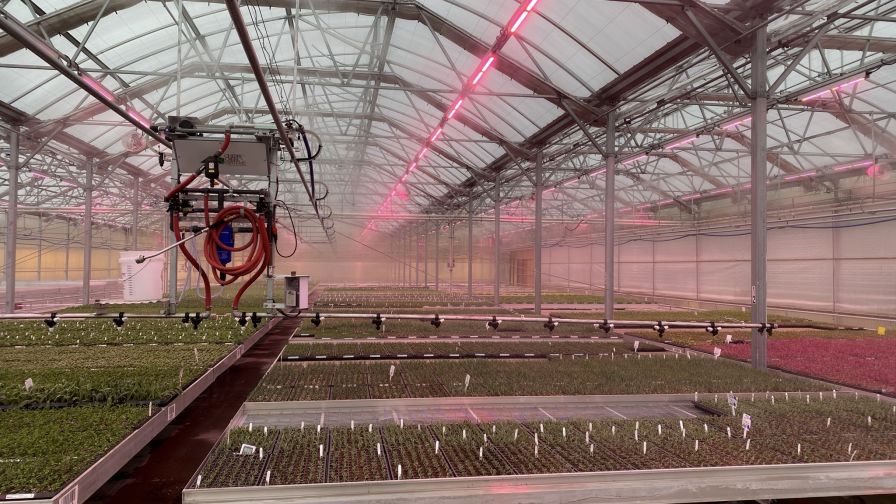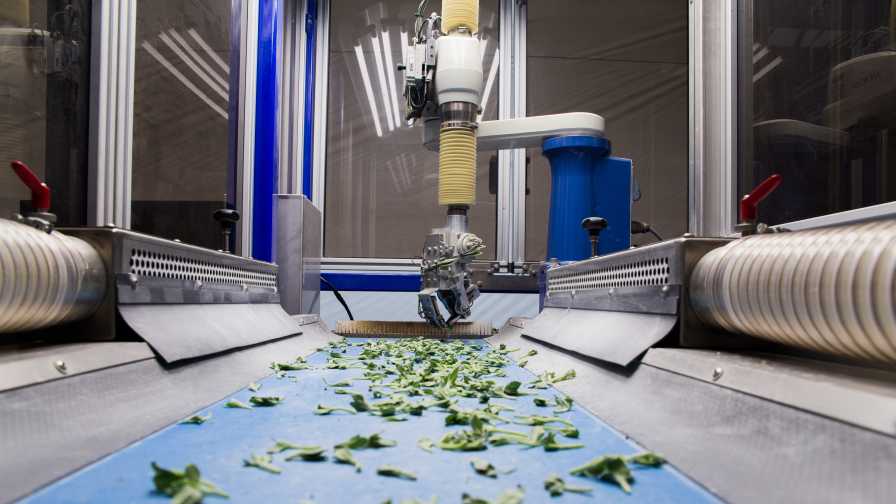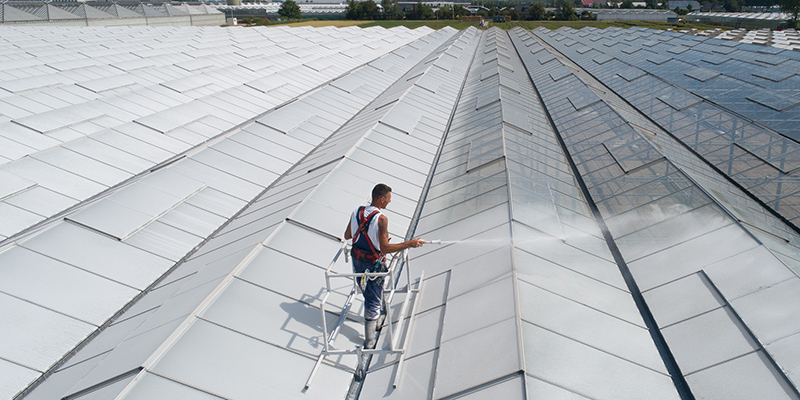8 Trends Driving Grower Technology Adoption

The Skagit Horticulture team has a committee that looks five to 10 years down the road to figure out where the company wants to be, and the tools they may need at that time. Photo: Skagit Horticulture
Every greenhouse grower, regardless of size or crops grown, likely looks at technology and automation through the same lens: Does it make my operation more efficient, does it help me save on labor and other costs, and does it help me improve plant quality?
For those growers who are part of Greenhouse Grower’s Top 100 list, their answers may be a bit different due to the scale on which they are operating. But the path they take to get to those answers certainly runs parallel to others.
I recently looked for answers to these questions and more with two of the growers on Greenhouse Grower’s Top 100 Growers list: Scott Crownover, President and CEO of Skagit Horticulture (#23) in Mt. Vernon, WA; and Mike Goyette, Operations Manager at Pleasant View Gardens (#94) in Loudon, NH. Keep reading for their insights and suggestions.
What You Don’t Need Now, You May Need Later
The Skagit Horticulture team has a committee that looks five to 10 years down the road to figure out where the company wants to be, and the tools they may need at that time.
“We have technology in place today that certainly works well for us now, but when it comes time for us to expand, will it still be the right fit for us?” Crownover says. “Our industry is in a great spot thanks to the emergence of new markets that are drawing in a range of new innovations. Something that may not be practical for us to implement today may in fact be necessary down the line.”
Goyette says visiting with other growers or having conversations at trade shows can also spark new ideas, even if they aren’t a good fit at first.
“Sticking robots are a great example of this. When they first came out, we saw how well they could work, but the return on investment wasn’t there,” he says. “But we kept our options open, and eventually got to a point where we felt comfortable adding them. Since then, we haven’t looked back.”
Being the Guinea Pig Isn’t Easy
Both Skagit and Pleasant View have several types of new technology on their radar, but in today’s climate, the risk of being the first to adopt them is daunting.
“We feel like if we keep our eye on what’s going on in the market and do our research, we’ll be in the position when the time comes to adopt,” Crownover says. “But we do want to wait until the technology is proven. I may not be looking at it now, but ask me a year from now and my answer might be different.”
Quality Has Its Own Return on Investment
The needs of your customers, and their quality expectations, will ultimately dictate where and when you will invest in new technology, says Goyette, pointing to recent examples of Pleasant View upgrading its lighting systems.
“We realized we had to meet demands for better-rooting plants with less shrinkage, which meant they needed more micromoles of light,” Goyette says. “Not only was it the right thing to do, but the numbers supported the payback.”
Conversely, this sometimes means saying no to a new investment.
“The return isn’t always there, and sometimes that is the true answer,” Crownover says.

Pleasant View Gardens currently uses five ISO Group Cutting Planter machines, with two more on the way. Photo: ISO Group
Labor, As Always, Is a Driving Factor
When Crownover and Goyette talk about labor as a concern, it’s not just about availability. It’s also about cost, especially in areas where minimum wages are rapidly rising.
“I don’t like to use the word ‘reducing’ when it comes to labor, because we never seem to do this,” Crownover says. “We just don’t want to add any more people, which speaks to our need to consider automation. What can we do to not require more bodies in the greenhouse?”
One advantage Skagit does have is its location. There are several other types of farming operations in the area where the needs for labor might overlap, and Skagit has formed partnerships with some of these growers to move people from one farm to another (which also helps the company navigate ever-changing regulations over the number of hours a person can work at one location in a week’s time). More importantly, the proximity of major tech companies such as Microsoft and Amazon gives Crownover and the Skagit team exposure to automation technology that is further down the road, such as driverless trucks.
Supply Chain Challenges Require Advance Ordering
Skagit Horticulture is perhaps unique in that it has an entire supply chain department that wrapped up its 2023 purchasing six months ago, and hopes to be covered through 2025 by early March of 2023.
“We can always adjust as needed down the road, and if we end up with too much product such as plastic, we can work with smaller growers who may not have ordered plastic in time,” Crownover says.
At Pleasant View, Goyette says lead time adjustments have been a big focus, especially when it comes to capital improvements and expansion.
“We’ve had to pull the trigger faster than usual when placing orders to account for longer lead times,” Goyette says. “We’ve also moved some of our ordering from offshore to onshore. It may be slightly more expensive, but it means we’ll actually get the materials we need.”
Strategize for Internal Efficiency
Goyette says when it comes to making changes within the greenhouse to account for labor efficiencies, he focuses on low-hanging fruit.
“We’ll work top down on labor costs, understand where small changes will have the most impact and apply lean principles to increase efficiencies. These small changes on quantity/high-cost jobs have a big impact on reducing labor costs. We may not be able to invest in a complete line of new conveyors, but we can add one more cutting machine that helps improve opportunity costs in other areas of the business,” Goyette says.
The energy costs in running a greenhouse can also be challenging, which is why Skagit pre-orders its natural gas months in advance.
“If you buy it on the spot, the cost is going to be much higher,” Crownover says.
Having a Robust ERP System Is Critical
There was a time when you could invest in an enterprise resource planning (ERP) system, and then wait 10 years before upgrading it. But those days are gone.
“We need to have finance and inventory accuracy at our fingertips, so we can respond quickly,” Crownover says. “Having a robust ERP system is critical to surviving in this industry. You have to know your numbers, and you have to have people who can interpret those numbers and drive your business based on those numbers.”
Goyette says the right system can also help you “squeeze more from the sponge” that is your team and your finances.
“You may be operating as efficiently as possible, but then someone will ask if they can take an extra allocation,” Goyette says. “Your first thought is probably going to be ‘from where?’, but if you really know your numbers and your costs, you can figure out where you can gain those extra efficiencies.”
Get Buy-in From Your Team
Even the most advanced, high-tech automation systems will only work if the team using it sees its value. Skagit learned this lesson when it installed a new transplanting machine.
“We put it in the facility and just told our team to go use it,” Crownover says. “They found every excuse not to use it until we gave them ownership of the machine and let them figure out how to take advantage of it. Now they can’t stop using it.”
Sometimes your team may even end up using a new machine in a way you hadn’t intended.
“As managers, it’s easy for us to sit in our offices and come up with ideas,” Crownover says. “But sometimes the best implementation comes from the people actually using the machine.”
Goyette notes that sometimes the odds of new technology working well is based on the experience of your team.
“If we have a newer team in place, we’ll probably want to give them something that’s simple to use,” he says. “But if they’re more experienced, they’ll be more likely to take something new and run with it.”
Goyette also says if you can visually demonstrate why your current processes aren’t working, it can make your team more excited about trying something new.
“We try to point out where the bottlenecks are in the production system, so we can show our team why making a change by adding a new machine just makes sense,” he says. “If they can see it for themselves, they are more likely to buy in.”









